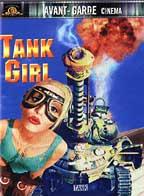LITR 4632: Literature of
the Future

|
Student Presentation 2005 |
|
Annie McCormick
Tank Girl

Tank
Girl (1995); directed by Rachel Talalay; based on a comic strip by Alan
Martin and Jamie Hewlett
Primary Objectives—Narratives & Visions of the Future
1. To identify, describe, and criticize narratives or stories humans tell about the future:
a. Apocalyptic
b. Evolutionary
c. Alternative
At some point in history, in rather apocalyptic fashion, a
comet destroyed earth. There is little population left and the world that remains is
a vast desert. The movie centers on
the survival and comedy of Tank Girl. It
is now 2033 and it has not rained in eleven years.
The little amount of water that does remain on earth is controlled by a
mega-corporation, Water and Power. As
Tank Girl says, they “control most of the water and have all the power.”
There is a new sort of super-soldier invented from altering kangaroo DNA
that creates a half-man/half-animal killing machine, called Rippers. They are
also referred to as “human eating creatures.” Along
with Tank Girl, they decide to go up against Water and Power to try to get some
freedom. Pieced together throughout
the movie are also comic book stills, singing and dancing, and even a love
interest that develops between Tank Girl and a Ripper.
Question #1:
This movie deals with foreseeable future problems, such as DNA altering
and a lack of water, but they are covered up with a large amount of humor.
Is comedy a way for people to deal with issues that are happening or that
might happen in the future? Is it a
constructive reaction to problems?
Question #2:
There is no substantial mention of a government in this movie.
The most powerful figures seen are those involved with Water and Power.
In Stone Lives, there is a
similar situation with the Citrine corporation.
Why is it that future scenarios suggest that governments are giving way
to corporations? Are we beginning
to see the signs of that today?
